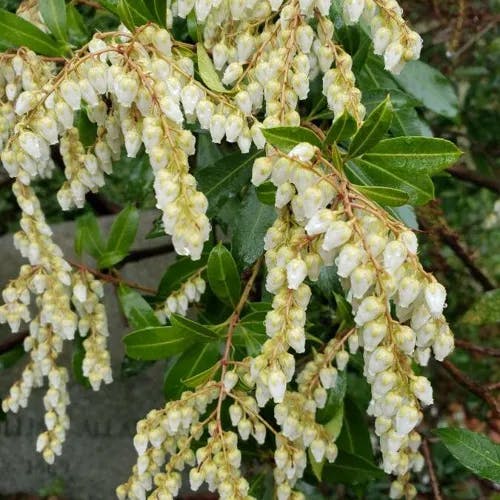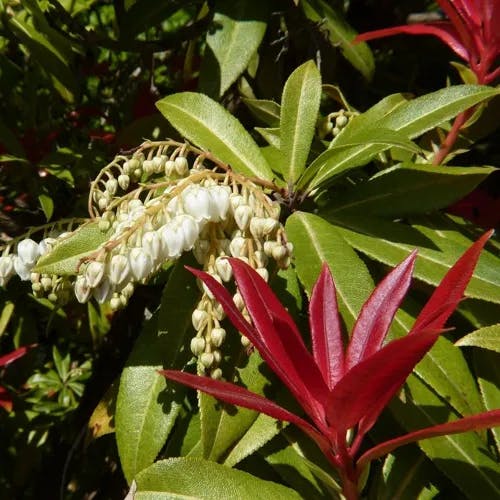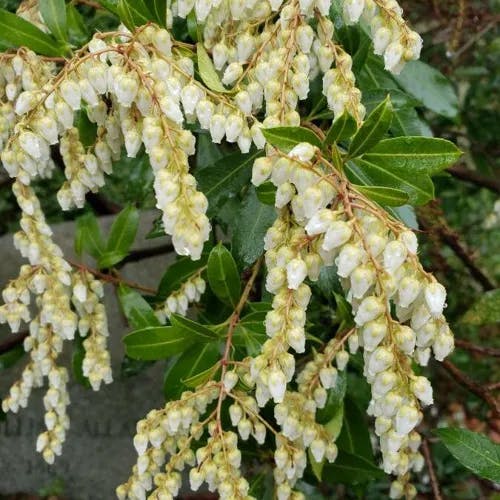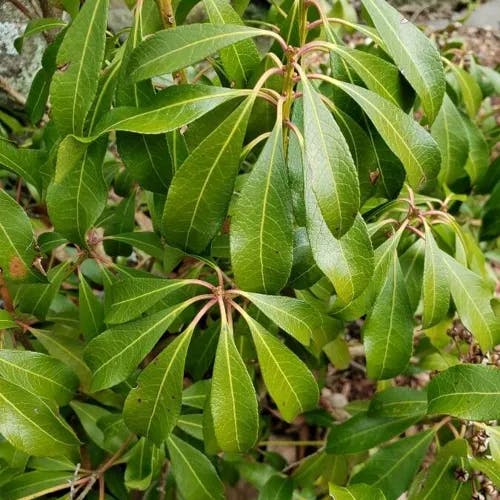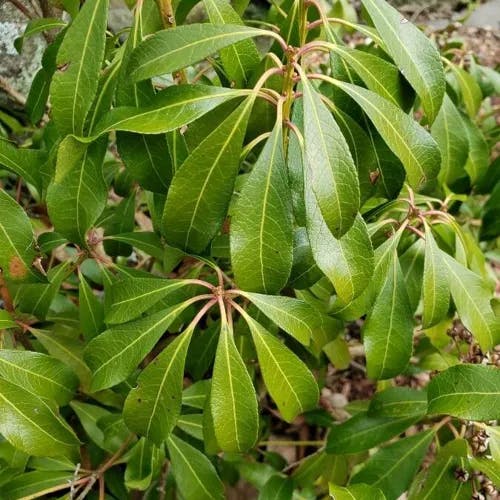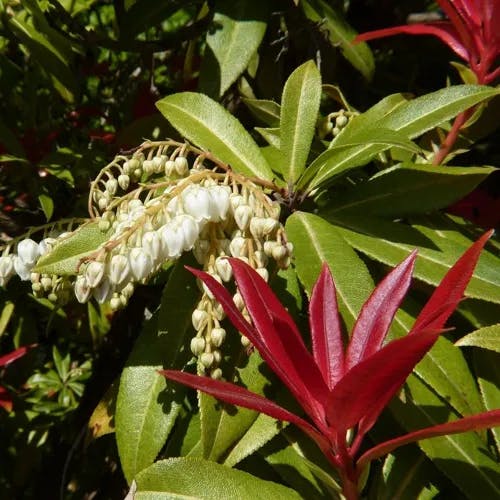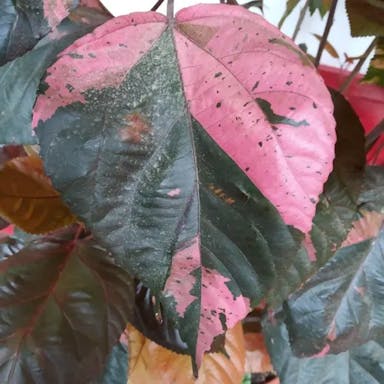Pieris japonica, commonly known as Japanese pieris, is a plant species native to eastern Asia, specifically Japan, Taiwan, and eastern China. It belongs to the Ericaceae family, which is primarily composed of flowering plants. This plant is an evergreen shrub that can grow up to 4 meters in height. It has a slow growth rate, making it relatively easy to manage in a garden setting. The leaves are alternate, lanceolate, and have a leathery texture, with a glossy dark green color on the upper surface and a lighter green on the underside. The flowers of Pieris japonica are bell-shaped and typically white, although some varieties may exhibit pink or red hues. They are arranged in pendulous racemes that can reach up to 15 cm in length. The flowering period is in early spring, providing a vibrant display that attracts various pollinators. The fruit of Pieris japonica is a capsule, which splits open when mature to release numerous small seeds. The seeds are wind-dispersed, allowing the plant to propagate over a wide area. In terms of symbolism, the Japanese pieris is often associated with meditation and peace, likely due to its tranquil appearance and slow growth habit. There are several cultivars of this plant available, each with its unique characteristics, such as 'Mountain Fire' with its red new growth, and 'Variegata' with its variegated leaves. Despite its exotic origins, Pieris japonica is relatively easy to grow in temperate climates. It prefers acidic soil and partial shade, making it a popular choice for woodland gardens. However, it is susceptible to certain pests and diseases, such as lace bugs and root rot, so regular monitoring and appropriate care are necessary.
Japanese Pieris
- Common name
- Japanese Andromeda,Japanese pieris
- Scientific name
- Pieris japonica
Basic Information
- Ericaceae Family Pieris Genus Japanese Pieris Species
- Ericaceae > Pieris > Pieris japonica
- 83%
- The Completeness of This Encyclopedia
Please help us complete the encyclopedia, Terrarium is a encyclopedia service to be completed with everyone in the world. Currently, this page is 83% complete. For more information on how to contribute, please click here.
- Shrub
- Height
- 300cm ~ 400cm
- Flower Color
- Leaf Color
- Anthesis
- spring
- Sunlight Exposure
Full Sun Long hours of sunlight from morning to afternoon Partial Shade A location in the shade of a tree or where either the morning or afternoon is shaded Full Shade A place where there is no direct sunlight
- Partial Shade
- Hardiness Zones
This is an indicator to know to which zone each plant can winter. Knowing the zone of each plant gives you an idea of the cold temperature resistance when grown in the ground without a roof. 2: -42.7 to -40.0 3: -39.9 to -34.4 4: -34.3 to -28.9 5: -28.8 to -23.3 6: -23.2 to -17.8 7: -17.7 to -12.2 8: -12.1 to -6.7 9: -6.6 to -1.1 10: -1.0 to 4.4 11: 4.5 to 10.0
- 5-8
- Cold resistance
- Good
- Heat resistance
- Fair
- Habitat of origin
- Japan, China, Taiwan
- Growth Rate
- Normal
What is Japanese Pieris (Pieris japonica)?
What is Japanese Pieris (Pieris japonica)
Flower meaning
Pieris japonica, also known as Japanese pieris, is a plant native to eastern Asia. In the language of flowers commonly used in America, it symbolizes a desire for solitude or a sense of caution. For instance, giving someone a bouquet that includes Japanese pieris could be interpreted as a gentle reminder to be careful or a subtle hint that the giver values their alone time. However, it's important to note that the meanings can vary depending on the context and the personal beliefs of the recipient. Unfortunately, Japanese pieris is not recognized as a birth flower in the American tradition, so there is no specific month or date associated with it. #N/A
Calendar of Japanese Pieris (Pieris japonica)
Calendar
Pieris japonica, also known as Japanese pieris, typically begins its flowering period in late winter to early spring in the United States. The peak blooming time usually falls between February and April, depending on the local climate. The plant produces clusters of bell-shaped flowers that can last for several weeks, making it a popular choice for early spring color. To extend the blooming period, it's important to provide the plant with optimal growing conditions. This includes well-drained soil, partial shade, and regular watering. Pruning immediately after flowering can also help to promote a more vigorous bloom the following year. However, avoid heavy pruning as this can stress the plant and reduce flowering. In colder regions, a layer of mulch can help to protect the plant during winter and ensure a healthy bloom in spring. Remember, the timing of flowering can vary slightly based on local weather conditions and the specific growing environment.
How to grow Japanese Pieris (Pieris japonica)
Watering
Pieris japonica, also known as Japanese pieris, requires moderate watering. During the growing season, from spring to early fall, water the plant once a week. Ensure the soil is moist but not waterlogged, as overwatering can lead to root rot. In the winter months, reduce watering to once every two weeks. The soil should be allowed to dry out slightly between waterings during this period. The amount of water will depend on the size of the plant, but generally, 1-2 liters per watering session is sufficient for a medium-sized shrub. Remember to adjust watering frequency based on weather conditions; in hot, dry periods, the plant may require more frequent watering. Always check the soil's moisture level before watering; it should feel slightly damp to the touch. Use a watering can or hose with a gentle spray to avoid disturbing the soil around the plant.
Soil and Fertilizer
Pieris japonica, also known as Japanese pieris, thrives in well-drained, humus-rich soil. The soil should be acidic, with a pH range of 4.5 to 6.0. This plant prefers cool, moist soil conditions, but it can tolerate some drought once established. Fertilizer application should be done in early spring, using a slow-release, acid-forming fertilizer such as those designed for rhododendrons or azaleas. Apply the fertilizer according to the package instructions, typically at a rate of 1 pound per 100 square feet. A second application can be made in late summer if the plant appears to need a nutrient boost. Avoid over-fertilizing, as this can lead to salt accumulation in the soil and potential root damage. Maintaining the soil's organic matter content and acidity will help ensure the health and vigor of your Pieris japonica.
Sunlight and Place
Pieris japonica, also known as Japanese pieris, is a plant that thrives in partial to full sun exposure. It can tolerate a wide range of sunlight conditions, from full sun to partial shade. The plant is cold hardy and can withstand temperatures down to -20 degrees Fahrenheit. However, it prefers a cooler climate and may struggle in extreme heat. In terms of placement, Pieris japonica should be positioned where it can receive morning sunlight and afternoon shade. This helps to prevent leaf scorch from intense midday sun. The plant is not particularly strong in sunlight and can suffer from leaf burn if exposed to too much direct sunlight. Ideally, it should receive around 4-6 hours of sunlight per day. During the summer, the plant requires regular watering to prevent drying out. In winter, it can tolerate cooler temperatures and less frequent watering.
Advanced Information of Japanese Pieris (Pieris japonica)
Pruning
Pieris japonica, also known as Japanese pieris, requires regular pruning to maintain its shape and promote healthy growth. Pruning is necessary to remove dead or diseased branches, encourage bushier growth, and improve air circulation within the plant. The best time to prune Pieris japonica is in early spring, just after the plant has finished blooming. To prune, use sharp, clean pruning shears to cut back any dead, diseased, or crossing branches at their base. Also, trim back any overly long branches to maintain the desired shape of the plant. After pruning, it's important to clean up and dispose of the cut branches to prevent the spread of disease. Finally, water the plant thoroughly and consider applying a balanced fertilizer to support new growth. Remember, over-pruning can stress the plant, so it's best to remove only about one-third of the plant's total growth each year.
Planting and Harvest
Pieris japonica, also known as Japanese pieris, is a plant that thrives both in-ground and in pots. When potting, choose a container with good drainage and use a well-draining soil mix. Place the plant in the pot, ensuring the top of the root ball is level with the soil surface. Water thoroughly after planting. For repotting, do so every 2-3 years or when the plant outgrows its pot. Carefully remove the plant, trim any dead roots, and place in a larger pot with fresh soil. Mishowing, or incorrect display, can be avoided by placing the pot in a location with partial shade and regular watering. Avoid overwatering as this can lead to root rot. Ensure the plant is not exposed to extreme temperatures as it prefers cool to moderate conditions. Regularly prune to maintain shape and promote dense growth.
Propagation
Pieris japonica, also known as Japanese pieris, can be propagated through seeds, cuttings, or layering. To propagate from seeds, collect mature seeds from the plant in late summer or early fall. Sow the seeds in a well-draining soil mix, cover lightly with soil, and keep moist. Germination usually occurs in 2-3 weeks. For propagation through cuttings, take semi-hardwood cuttings in late summer. Dip the cut end in rooting hormone, then plant in a pot filled with a mixture of peat and perlite. Keep the cuttings in a humid environment until roots develop. Layering is another effective method. Bend a low-growing branch to the ground, cover a section with soil, and secure it with a stone or peg. Roots will form at the point of contact with the soil. Once rooted, the new plant can be severed from the parent plant and transplanted.
Pests and Diseases
Pieris japonica, also known as Japanese pieris, is susceptible to several pests and diseases. One of the most common pests is the lace bug, which feeds on the undersides of leaves, causing them to turn brown and fall off. To prevent lace bug infestations, it's recommended to regularly inspect the plant, especially during the warmer months when these pests are most active. If an infestation is detected, insecticidal soaps or oils can be used to control the population. Another pest that can affect Pieris japonica is the black vine weevil. This pest feeds on the roots of the plant, causing wilting and potentially death if not controlled. To prevent black vine weevil infestations, it's recommended to use beneficial nematodes or insecticides. In terms of diseases, Pieris japonica is susceptible to root rot, which is caused by a fungus in the soil. This disease causes the roots to decay, leading to wilting and yellowing of the leaves. To prevent root rot, it's important to ensure the plant is not overwatered and that it's planted in well-draining soil. If root rot is detected, the affected plant should be removed and the soil replaced to prevent the spread of the fungus. Leaf spot is another disease that can affect Pieris japonica. This disease causes brown or black spots on the leaves and can lead to defoliation if not treated. To prevent leaf spot, it's recommended to avoid overhead watering and to regularly remove any fallen leaves from the base of the plant. If leaf spot is detected, fungicides can be used to control the disease.
Habitat of Japanese Pieris (Pieris japonica)
Habitat
Toxicity of Japanese Pieris (Pieris japonica)
Health Benefits
- edible
- Inedible
- Toxic
- toxic
NO DATA
Toxic for dogs and cats
NO DATA
Q&A of Japanese Pieris (Pieris japonica)
- What is the availability of Iris ensata bulbs or seedlings?
Iris ensata, often known as Japanese Iris, bulbs and young plants, are typically easy to find at garden centers and online plant shops, especially during the planting seasons of spring and autumn. However, their availability can vary depending on your geographical area and the time of the year. It's essential to stress that Japanese pieris, scientifically designated as Pieris japonica, represents a wholly separate botanical species. Consequently, if your quest is for Japanese pieris, you might not find it marketed under the name Iris ensata. Although both plants hail from Japan, they showcase contrasting growth characteristics and maintenance needs. To recap, if you're in search of Iris ensata bulbs or young plants, you can usually find them easily. However, be diligent in distinguishing them from Japanese pieris. Always double-check the scientific names when making a purchase to avoid any potential mix-ups.
- What is the difference between Japanese iris and Siberian iris?
The Japanese iris (Iris ensata) and the Siberian iris (Iris sibirica) both belong to the Iris genus, but they possess unique characteristics. Indigenous to Japan, the Japanese iris is renowned for its large, flat blossoms that display vibrant hues, typically ranging from purple and white to pink. It thrives in acidic soil and is commonly cultivated in water gardens or along the margins of ponds. In contrast, the Siberian iris, hailing from Northern Asia and Europe, boasts petite and delicate blooms, typically adorned in shades of blue and purple. This particular iris variety demonstrates impressive versatility in accommodating various soil types and is frequently employed as border foliage or ground cover. It's crucial to underscore that Japanese pieris (Pieris japonica) is an entirely separate plant with no connection to either of these iris species. Japanese pieris is an evergreen shrub that features charming bell-shaped flowers and falls under the Ericaceae family category.
0
0
- What is the life span of Siberian iris in a vase?
When placed in a vase, a Siberian iris typically enjoys a vase life that spans from 3 to 6 days. The exact duration can vary based on the quality of care and environmental conditions. It's essential to differentiate this vase life from the plant's typical longevity, which can extend over several years in its native habitat. Conversely, the Japanese pieris, scientifically designated as Pieris japonica, stands as an evergreen shrub with the potential to flourish for many years, even reaching several decades under ideal conditions. Nonetheless, once its blossoms and foliage are clipped and artfully arranged in a vase, their longevity is also about a week, mirroring that of the Siberian iris. To extend the duration of both these plants in a vase, it's crucial to ensure they have access to clean, fresh water and are placed in a clean vase. Keep them in a cool area with indirect lighting. Additionally, cutting the stems at an angle can aid in water absorption. Please keep in mind that these are general recommendations, and the actual results may vary depending on your specific circumstances.
- When to plant Japanese Iris bulbs?
Iris ensata, commonly referred to as Japanese Iris bulbs, are ideally planted during late summer to early fall. This timing facilitates root establishment before the arrival of winter. Keep in mind that these plants thrive in slightly acidic soil and require a sunny spot for optimal growth. If you're gardening in a cooler climate, it might be beneficial to offer some winter protection to safeguard the bulbs from the cold. Consistent watering is essential, but be cautious about overwatering, as it can promote bulb rot. With proper care, you can anticipate delightful blooms from late spring to early summer.
0
0
- Is there a recommended way to choose Pieris japonica?
Pieris japonica, also known as Japanese Andromeda, offers a range of varieties, each with its own distinctive traits. When making a selection, consider 'Mountain Fire' for its striking red new growth, or 'Variegata' for its eye-catching variegated leaves. For seedlings, seek out those with robust, healthy foliage and a well-developed root system. When purchasing seeds, make sure they are fresh and come from a reputable source. If you have limited space, 'Cavatine' is a dwarf variety that fits perfectly. For a garden with a monochromatic theme, 'Purity' produces pristine white flowers. Keep in mind that Pieris japonica thrives in acidic soil, so choose a variety that aligns with your soil's pH. Lastly, 'Pink Delight' adds a pop of color with its unique pink flowers, setting it apart from other Pieris japonica varieties. Select the variety that best complements your garden's requirements and aesthetic preferences.
